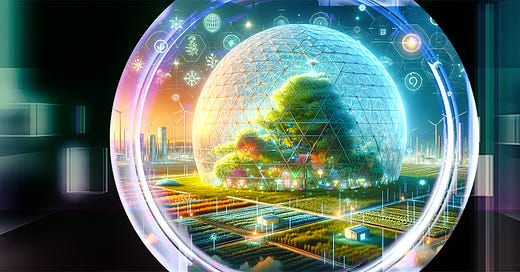The Lever Long Enough: How tech moves the world
For some time, the technology sector has gotten a bad rap. The public has accused tech companies of excessive power, prioritizing profits over privacy, stifling competition, or contributing to societal issues. And these statements do carry weight. But while some of these opinions can be substantiated when directed at subsets of the tech sector, this does not tell the full story.
On our team, we often reference a quote from Arthur Clarke, “Any sufficiently advanced technology is indistinguishable from magic.” And if you’ve gotten hands on with any Generative AI tools, seen 400-foot rockets be caught by chopsticks, or seen a visual impaired person using specialized glasses to see the world in color for the first time, you can agree: much of today’s technology does feel like magic.
An author who delivers great punch-per-word is C.S. Lewis, who says, “So great as anything's potential for good, equally great is its potential for evil. A cow has limited potential for good, and a limited potential for evil. A human, however, has great potential good, and great potential for evil." With these magical gadgets in hand, a human’s capacity for good and evil has grown considerably, and this growth is accelerating. So, as people who want to see human flourishing around the world, the question becomes: what good can we the people do with these new tools?
Here are a few inspiring stories that answer that question, in the hopes of jumpstarting your own imaginations for what you can do:
Preventing human trafficking: Over 27 million people 1 (by some estimates) are currently being trafficked globally for domestic servitude, forced child labor, sex trafficking, and other reasons. A problem of this magnitude needs every innovation possible.
Several burgeoning AI startups are partnering with law enforcement to match security camera footage with missing persons reports, enabling them to identify victims by only a fraction of their face visible on recordings. 2 While security camera footage has long been utilized by law enforcement, the amount of data and the increased range of usable data quality with the latest AI has changed the game. Other companies are focusing on pattern recognition and data analysis, utilizing AI to analyze large datasets and expose complex trafficking networks that exceed human analytical powers.3
Wildfire management: Wildfires are horrific, as we’ve seen just recently in Maui, California, an Australia. Each year, there are tens of thousands of such fires, destroying millions of acres and taking many human lives.4 And with changes in climate, wildfires are a higher risk than ever.
One way public and private organizations are approaching this problem is with drones. The largest consumer of drones is not the Department of Defense, as I had assumed, but the Department of the Interior. By using drones equipped with thermal imaging to detect and track forest fires, the DOI has been able to mitigate fires faster and prevent unquantifiable damage to wildlife, property, and the atmosphere. 5 In the years ahead, larger drones may fly equipped with fire retardant and other helpful chemicals to improve response times and further minimize damages.
Access to clean water: 71% of the Earth is water. However, there are over 1 billion people globally without access to clean drinking water. I write this piece in my kitchen, with a sink in front of me providing an effectively endless supply of safe drinking water, while 1 in 8 people around the world is water insecure. What is being done to help?
Among others, a company called LifeStraw 6 is pioneering opportunities through technical advancement. By creating a filter straw (from sustainable materials) that is cost effective, easily portable, and filters 1,000 gallons per straw, LifeStraw provided access to clean drinking water for 9.6 million kids around the world. While this is only a drop in the bucket, it is world changing for every kid involved.
The BC-era Greek mathematician Archimedes once said, “Give me a lever long enough and a fulcrum on which to place it, and I shall move the world.” I fully believe that the lever of our day capable of moving the whole world is technology. As discussed above, technology can infiltrate and transform the world’s biggest problems. From human-trafficking to global warming, to the global water crisis, and so many more, technology can be the bridge. The question is not if tech will move the world, but to where.
This answer largely depends on the people involved. A lever is only as effective as the one wielding it. With tech as a force multiplier in the hands of people seeking positive change, the world really can change for the best. However, without accompanying policies, funding, and deployment, these tech developments – and the impact they promise – will be held at bay and stuck in the mud. Legislators, leaders, and dreamers alike should harness the power of emerging technologies and see beyond quarterly earnings reports and annual bonuses. To fully capture the promise of the newest technologies, we must have a shared vision of a brighter, more equitable tomorrow.
To close, two favorite quotes:
“Technology is a useful servant but a dangerous master.” -- Christian Lous Lange
“Technology is best when it brings people together.” -- Matt Mullenweg
Let’s put these tools in the right hands so they can be a force for GOOD.
-Mark Osis | Senior Consultant, Office of the CTO (NExT) at Deloitte






